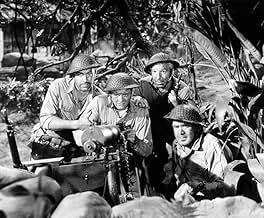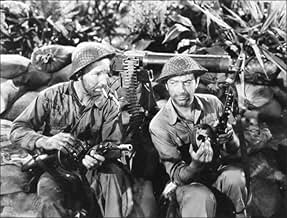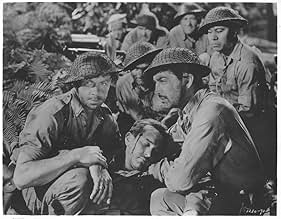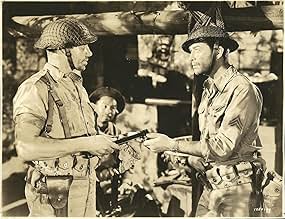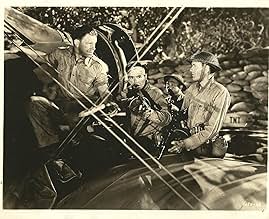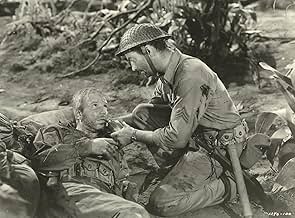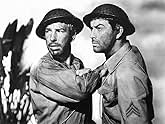Aggiungi una trama nella tua linguaIn 1942, in the Bataan peninsula of the Philippines, a ragtag American unit commanded by Sergeant Bill Dane attempts to blow-up a bridge in order to slow the Japanese advance.In 1942, in the Bataan peninsula of the Philippines, a ragtag American unit commanded by Sergeant Bill Dane attempts to blow-up a bridge in order to slow the Japanese advance.In 1942, in the Bataan peninsula of the Philippines, a ragtag American unit commanded by Sergeant Bill Dane attempts to blow-up a bridge in order to slow the Japanese advance.
- Regia
- Sceneggiatura
- Star
- Premi
- 5 vittorie totali
- Yankee Salazar
- (as J. Alex Havier)
- Wounded Soldier
- (non citato nei titoli originali)
- Japanese Soldier
- (non citato nei titoli originali)
- Japanese Soldier
- (non citato nei titoli originali)
- Infantry Soldier
- (non citato nei titoli originali)
Recensioni in evidenza
The jungle setting (although filmed on the studio lot) is impressive with its exotic foliage and adds to the realism. The hand to hand combat scenes are well staged, as are the final moments of the film.
All in all, a gripping war film that more than holds its own with contemporary stories like SAVING PRIVATE RYAN.
Has to be appreciated in the context of its time--when flag-waving patriotism was at its peak and lines like "Those dirty Japs" were not considered politically incorrect.
Yes, you can say some of the soldiers are clichéd, but death is shown unflinchingly. Combat is portrayed as a bloody, messy, fatigue-inducing business. Boredom and endless waiting take their toll on nerves as well. The banter and cocky talk is whistling past the graveyard.
Lloyd Nolan's character is rough and unlikeable. He fights for freedom, but he fights dirty and he doesn't pretty things up with patriotic speeches. Some might complain about the black soldier playing harmonica and taking orders from white men. Actually, for the time, he was portrayed with dignity and shown to be as brave as any of the other soldiers. As for Robert Taylor, his weariness and resolve at the end are stirring and the last scene is not one you will soon forget.
Ignoring the propaganda aspects of the movie, the last half works as almost a pure horror movie, as our cast gets gruesomely picked off by unseen foes lurking in the jungle.
Exciting and gripping, it's easy to overlook the faults of this most violent and gritty of WW2 films made at the time.
"Bushido, Bushwa! You stink!" So died the heroes of Bataan...
Rather than try to show the entire evacuation and abandonment of the Phillipines, which would be perhaps overwhelmingly depressing, the film-makers decided to focus on one small, fictional incident that could, in effect, stand in for everything else. They chose wisely. What happens is that we watch a group of soldiers defend and then destroy a bridge, so as to slow down the Japanese army's advance, if only by a few hours, to buy precious time for everyone else. None of these men wants to be a hero. They're all stuck there, and would rather be someplace else. While some are more aggressive than others, no one is wholly brave; and though there is a good deal of nervousness and occasional cowardice, they all pull together admirably in the end.
Though filmed on the Culver City lot, the film cleverly and expressionistic ally suggests a tropical environment. As the story progresses the jungle gets foggier. It was never too inviting to begin with; by the movie's end it is absolutely forbidding.
The acting is variable. Some of the casting is peculiar. Thomas Mitchell plays a corporal named Feingold, but can't seem to get rid of the slight, American-style brogue that was so much a part of his screen persona. Desi Arnaz has a small role. There is a fairly straightforward presentation of a black man whose color is the least important thing about him. Robert Walker, in what I believe is his first film, has a showy role as a garrulous, yarn-spinning sailor. His character is, I imagine, supposed to be a typically charming, bumptious All-American boy, along the lines, perhaps, of Van Johnson. I find Walker,--who was an excellent actor--obnoxious in the part. Lloyd Nolan is tough as nails as a hard-case soldier with a dark past.
The movie's biggest asset in the acting department also happens to be its star: Robert Taylor. This pretty boy matinée idol gives a fine performance as the sergeant with a job no man in his right mind would want. And he is in his right mind. Taylor has no vanity in the part. He is as dirty and unshaven as everyone else in the cast, and at times shows flashes of depth and insight that are startling given his lightweight reputation. Taylor pulls the film together, with no Duke Wayne ostentation or posturing, and proves, like the film, to be stronger and truer to life than we might at first have imagined.
Lets get the complaints of others out the way first. Yes this is a studio shot production, yes there is model work involved, and yes this is unashamedly a flag waving, chest thumping, rally call of heroism. Based around actual events, this is a fictionalised telling that also has no shame in being disparaging towards the Japanese in the film. Now are these things really a problem? This is after all 1943, a time when the US was struggling in the Pacific conflict. A loose copy of John Ford's 1934 film The Lost Patrol, Bataan served as a moral booster for the public back home. The message is clear, this may be tantamount to a suicide mission, because, well, war is indeed hell, but sacrifices are necessary to achieve the bigger freedom objective.
Nicely directed by Tay Garnett {The Postman Always Rings Twice} and tightly scripted by Robert Hardy Andrews {The Cross of Lorraine}, the film stars Robert Taylor, George Murphy, Thomas Mitchell, Robert Walker, Desi Arnaz & Lloyd Nolan. Violent and brutal for its time {the hand to hand bayonet sequences are brilliantly realised}, Bataan is also notable for portraying a racially integrated fighting force having to come together for the greater good. This group of men are a mixed bunch, different backgrounds, different races and different classes. But they are in the same boat as the Japanese start to pick them off one by one, and not only that, but Malaria is in the camp as well. The tension is racked up, the atmosphere stifling, we the viewers are witness to a unique show of heroism as we live with these men during their last soul sapping days.
The cast do really well when one considers they are in fact playing disposable characters. Taylor in particular is effective as the tough Sergeant forced into command of the group. While some scenes such as a moodily staged camouflaged Japanese approach are truly memorable and linger long in the memory. The end also is terrific, one which puts one in mind of Sam Peckinpah watching and nodding approvingly. High on suspense and beating a real brave heart, Bataan is up with the best that the war genre of film has to offer. Belyng its budget restrictions it achieves its aims and then some. 8.5/10
Lo sapevi?
- QuizPrologue: "When Japan struck, our desperate need was time--time to Marshall our new armies. Ninety-six priceless days were bought for us--with their lives--by the defenders of Bataan, the Philippine army which formed the bulk of MacArthur's infantry fighting shoulder to shoulder with Americans. To those immortal dead, who heroically stayed stayed the wave of barbaric conquest, this picture is reverently dedicated."
- BlooperAlthough the American soldier was clearly a great coconut tree climber, it is near to impossible to sit atop a coconut tree. Many Filipinos to this day fall when attempting this.
- Citazioni
Sergeant Bill Dane: Come on, suckers! What's the matter with you? What are you waitin' for? Didn't think we were here, did you? You dirty rotten rats! We're still here! We'll always be here! Why don't you come and get it?
- Curiosità sui creditiClosing credits epilogue: So fought the heroes of Bataan. Their sacrifice made possible our victories in the Coral and Bismark Seas, at Midway, on New Guinea and Guadalcanal. Their spirit will lead us back to Bataan!
- Versioni alternativeAlso available in a computer colorized version.
- ConnessioniFeatured in Toast of the Town: A Salute to Lucy and Desi (1954)
- Colonne sonoreSt. Louis Blues
(1914) (uncredited)
Music and Lyrics by W.C. Handy
Sung a cappella and hummed often by Kenneth Spencer
I più visti
- How long is Bataan?Powered by Alexa
Dettagli
Botteghino
- Budget
- 958.000 USD (previsto)
- Tempo di esecuzione
- 1h 54min(114 min)
- Colore
- Proporzioni
- 1.37 : 1


